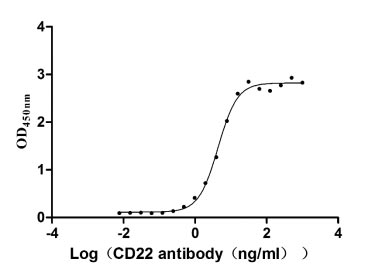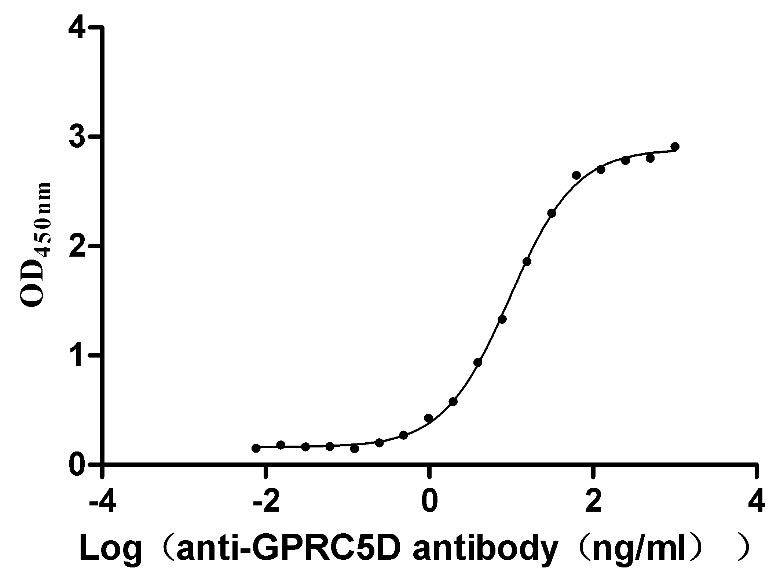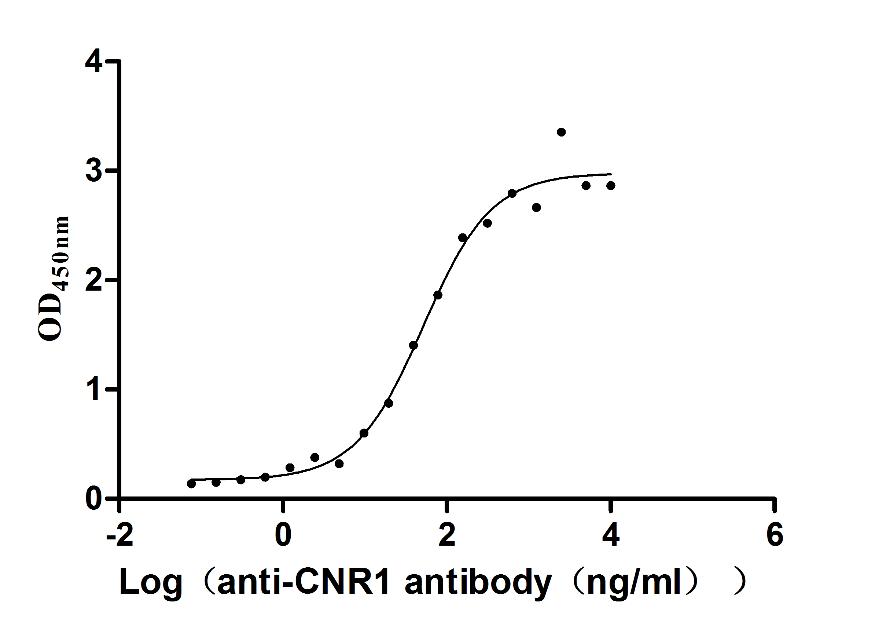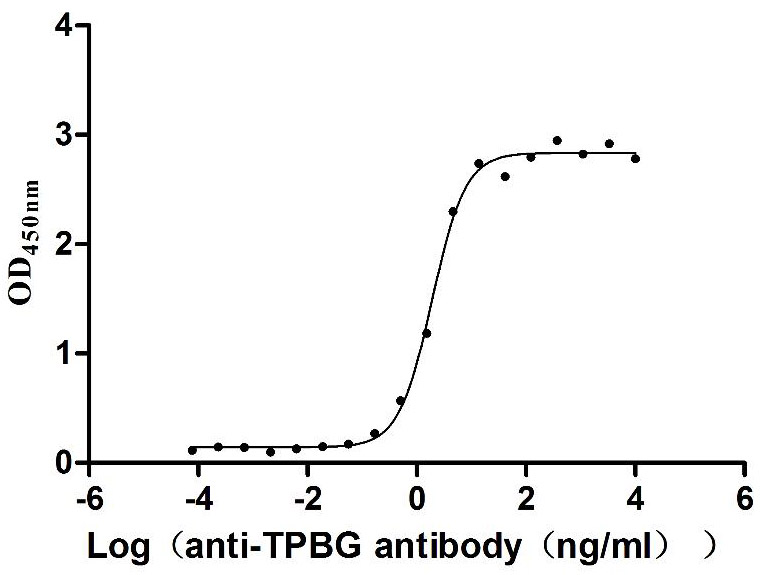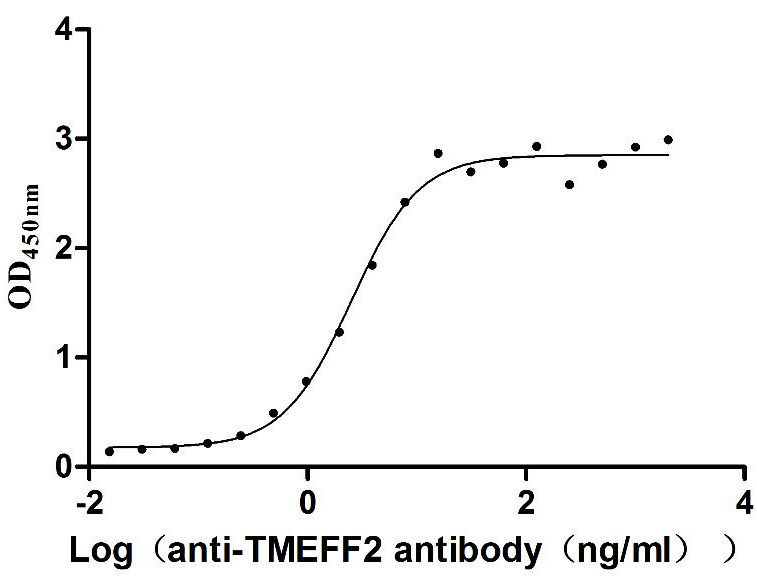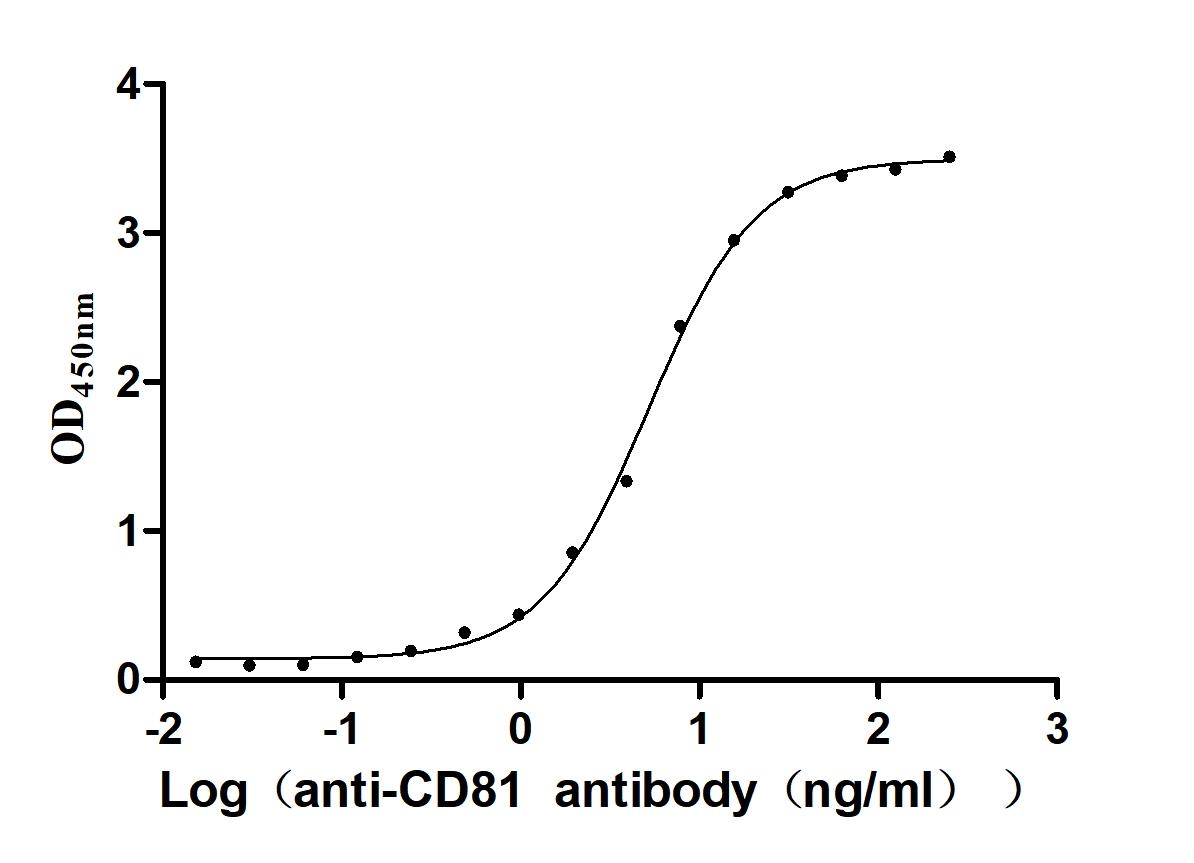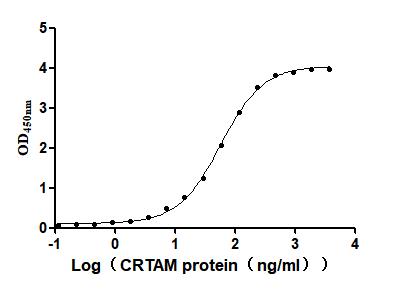Recombinant Human Agrin (AGRN), partial
-
中文名稱:Recombinant Human Agrin(AGRN) ,partial
-
貨號:CSB-YP001461HU
-
規格:
-
來源:Yeast
-
其他:
-
中文名稱:Recombinant Human Agrin(AGRN) ,partial
-
貨號:CSB-EP001461HU-B
-
規格:
-
來源:E.coli
-
共軛:Avi-tag Biotinylated
E. coli biotin ligase (BirA) is highly specific in covalently attaching biotin to the 15 amino acid AviTag peptide. This recombinant protein was biotinylated in vivo by AviTag-BirA technology, which method is BriA catalyzes amide linkage between the biotin and the specific lysine of the AviTag.
-
其他:
-
中文名稱:Recombinant Human Agrin(AGRN) ,partial
-
貨號:CSB-BP001461HU
-
規格:
-
來源:Baculovirus
-
其他:
-
中文名稱:Recombinant Human Agrin(AGRN) ,partial
-
貨號:CSB-MP001461HU
-
規格:
-
來源:Mammalian cell
-
其他:
產品詳情
-
純度:>85% (SDS-PAGE)
-
基因名:
-
Uniprot No.:
-
別名:AGRIN; Agrin C-terminal 22 kDa fragment; Agrin proteoglycan; AGRIN_HUMAN; Agrn; C22; C90; FLJ45064; OTTHUMP00000044043
-
種屬:Homo sapiens (Human)
-
蛋白長度:Partial
-
蛋白標簽:Tag?type?will?be?determined?during?the?manufacturing?process.
The tag type will be determined during production process. If you have specified tag type, please tell us and we will develop the specified tag preferentially. -
產品提供形式:Lyophilized powder
Note: We will preferentially ship the format that we have in stock, however, if you have any special requirement for the format, please remark your requirement when placing the order, we will prepare according to your demand. -
復溶:We recommend that this vial be briefly centrifuged prior to opening to bring the contents to the bottom. Please reconstitute protein in deionized sterile water to a concentration of 0.1-1.0 mg/mL.We recommend to add 5-50% of glycerol (final concentration) and aliquot for long-term storage at -20℃/-80℃. Our default final concentration of glycerol is 50%. Customers could use it as reference.
-
儲存條件:Store at -20°C/-80°C upon receipt, aliquoting is necessary for mutiple use. Avoid repeated freeze-thaw cycles.
-
保質期:The shelf life is related to many factors, storage state, buffer ingredients, storage temperature and the stability of the protein itself.
Generally, the shelf life of liquid form is 6 months at -20°C/-80°C. The shelf life of lyophilized form is 12 months at -20°C/-80°C. -
貨期:Delivery time may differ from different purchasing way or location, please kindly consult your local distributors for specific delivery time.Note: All of our proteins are default shipped with normal blue ice packs, if you request to ship with dry ice, please communicate with us in advance and extra fees will be charged.
-
注意事項:Repeated freezing and thawing is not recommended. Store working aliquots at 4°C for up to one week.
-
Datasheet :Please contact us to get it.
相關產品
靶點詳情
-
功能:heparan sulfate basal lamina glycoprotein that plays a central role in the formation and the maintenance of the neuromuscular junction (NMJ) and directs key events in postsynaptic differentiation. Component of the AGRN-LRP4 receptor complex that induces the phosphorylation and activation of MUSK. The activation of MUSK in myotubes induces the formation of NMJ by regulating different processes including the transcription of specific genes and the clustering of AChR in the postsynaptic membrane. Calcium ions are required for maximal AChR clustering. AGRN function in neurons is highly regulated by alternative splicing, glycan binding and proteolytic processing. Modulates calcium ion homeostasis in neurons, specifically by inducing an increase in cytoplasmic calcium ions. Functions differentially in the central nervous system (CNS) by inhibiting the alpha(3)-subtype of Na+/K+-ATPase and evoking depolarization at CNS synapses. This secreted isoform forms a bridge, after release from motor neurons, to basal lamina through binding laminin via the NtA domain.; transmembrane form that is the predominate form in neurons of the brain, induces dendritic filopodia and synapse formation in mature hippocampal neurons in large part due to the attached glycosaminoglycan chains and the action of Rho-family GTPases.; Isoform 1, isoform 4 and isoform 5: neuron-specific (z+) isoforms that contain C-terminal insertions of 8-19 AA are potent activators of AChR clustering. Isoform 5, agrin (z+8), containing the 8-AA insert, forms a receptor complex in myotubules containing the neuronal AGRN, the muscle-specific kinase MUSK and LRP4, a member of the LDL receptor family. The splicing factors, NOVA1 and NOVA2, regulate AGRN splicing and production of the 'z' isoforms.; Isoform 3 and isoform 6: lack any 'z' insert, are muscle-specific and may be involved in endothelial cell differentiation.; is involved in regulation of neurite outgrowth probably due to the presence of the glycosaminoglcan (GAG) side chains of heparan and chondroitin sulfate attached to the Ser/Thr- and Gly/Ser-rich regions. Also involved in modulation of growth factor signaling.; this released fragment is important for agrin signaling and to exert a maximal dendritic filopodia-inducing effect. All 'z' splice variants (z+) of this fragment also show an increase in the number of filopodia.
-
基因功能參考文獻:
- High Agrin expression is associated with Chronic obstructive pulmonary disease. PMID: 29351440
- The presence of agrin at locations with particular importance for the growth and stability of atherosclerotic plaques renders this molecule strategically positioned to influence plaque development and vulnerability PMID: 29405249
- C-terminal agrin fragment levels predict acute kidney injury after acute myocardial infarction. PMID: 28646861
- Agrin promotes oncogenesis through YAP-dependent transcription. PMID: 28273460
- Agrin strongly promotes chondrocyte differentiation and cartilage formation in vivo. PMID: 26290588
- Knockdown of agrin and perlecan promoted a decrease on cell migration and adhesion, and on resistance of cells to cisplatin. PMID: 25506919
- Among 42 hip fractured patients (age 83.7+/-8.6 years, 76.2% women), sarcopenia was diagnosed in 7 individuals (16.7%). Serum C-terminal agrin fragment (CAF) levels were significantly higher in sarcopenic relative to non-sarcopenic patients. PMID: 25304331
- In patients suffering from severe sepsis and septic shock, serum levels of C-terminal agrin fragment were significantly associated with kidney function and the need for renal replacement therapy and were not influenced by severe septic conditions. PMID: 25807640
- MuSK myasthenia gravis IgG4 disrupts the interaction of LRP4 with MuSK but both IgG4 and IgG1-3 can disperse preformed agrin-independent AChR clusters PMID: 24244707
- these observations indicate that agrin is another autoantigen in patients with MG and agrin autoantibodies may be pathogenic through inhibition of agrin/LRP4/MuSK signaling at the NMJ. PMID: 24632822
- Five new recessive mutations in the gene encoding agrin are identified in patients with congenital myasthenic syndrome. PMID: 24951643
- study identifies a spontaneous agrin mutation that reduces the ability of z+ agrin to activate MuSK and induce AChR clustering; this results in a severe congenital myasthenic syndrome in the patient, with both pre- and postsynaptic defects at the neuromuscular junction PMID: 22205389
- Dynamics of expression patterns of agrin in human glioblastoma PMID: 22307776
- In contrast to wild-type neurons which form synapses and survive for prolonged periods, agrin-deficient neurons do not mature and are rapidly eliminated in the transgenic olfactory bulb. PMID: 22423096
- Agrin immunohistochemistry may facilitate determination of primary versus metastatic origin in problematic liver cancer cases. PMID: 20471664
- different regions within the agrin protein are responsible for synapse formation at the neuromuscular junction and for process formation in central nervous system neurons PMID: 19940118
- Agrin, a heparan sulfate proteoglycan, is a component of the basal lamina of BBB microvessels, and growing evidence suggests that it may be important for the maintenance of the BBB. PMID: 12070669
- acts at the nerve-muscle synapse in the glomerular basal membrane and on T-lymphocytes PMID: 12073527
- evidence for additional functions of agrin during axonal growth, establishment of the blood-brain barrier, and Alzheimer's disease is accumulating--REVIEW PMID: 12270958
- Thus, an agrin/MuSK complex may form part of a motor neuron stop signal involved in "reverse signaling" to the motor neuron. PMID: 15691710
- in the NtA-laminin complex, conserved amino acids in the gamma 1 chain are prerequisite for the binding to agrin PMID: 15694127
- agrin has a role in binding alpha-synuclein and modulating alpha-synuclein fibrillation PMID: 16037493
- In human sperm an agrin isoform with a short NH2-terminus (agrinSN) localized in the posterior post-acrosomal, neck, and flagellar mid-piece regions. PMID: 16487930
- agrin might play an important role in neoangiogenesis in human HCC, being a part of the newly formed vasculature. In CC, however, agrin might be involved in tumor progression PMID: 17640714
- The agrin expression in human T cells is regulated by cell activation and IFN-alpha, and may have an important function during cell activation with potential implications for autoimmunity. PMID: 18025246
- study concludes that Abeta can modulate the cellular expression of agrin and glypican-1, which may contribute to the accumulation of these heparan sulfate proteoglycans in Alzheimer's disease lesions PMID: 19166823
- agrin facilitates the discrimination of benign and malignant hepatocellular lesions PMID: 19194276
- The agrin mutation does not interfere with its ability to induce postsynaptic structures but that it dramatically perturbs the maintenance of the neuromuscular junction. PMID: 19631309
- Observational study of gene-disease association. (HuGE Navigator) PMID: 19598235
顯示更多
收起更多
-
相關疾病:Myasthenic syndrome, congenital, 8 (CMS8)
-
亞細胞定位:[Isoform 1]: Secreted, extracellular space, extracellular matrix.; [Isoform 2]: Cell junction, synapse. Cell membrane; Single-pass type II membrane protein.
-
組織特異性:Expressed in basement membranes of lung and kidney. Muscle- and neuron-specific isoforms are found. Isoforms (y+) with the 4 AA insert and (z+8) isoforms with the 8 AA insert are all neuron-specific. Isoforms (z+11) are found in both neuronal and non-neur
-
數據庫鏈接:
Most popular with customers
-
Recombinant Human B-cell receptor CD22 (CD22), partial (Active)
Express system: Mammalian cell
Species: Homo sapiens (Human)
-
Recombinant Human G-protein coupled receptor family C group 5 member D (GPRC5D)-VLPs (Active)
Express system: Mammalian cell
Species: Homo sapiens (Human)
-
Recombinant Human Cannabinoid receptor 1 (CNR1)-VLPs (Active)
Express system: Mammalian cell
Species: Homo sapiens (Human)
-
Recombinant Macaca fascicularis Trophoblast glycoprotein (TPBG), partial (Active)
Express system: Mammalian cell
Species: Macaca fascicularis (Crab-eating macaque) (Cynomolgus monkey)
-
Recombinant Human Tomoregulin-2 (TMEFF2), partial (Active)
Express system: Mammalian cell
Species: Homo sapiens (Human)
-
Recombinant Human Early activation antigen CD69 (CD69), partial (Active)
Express system: Mammalian cell
Species: Homo sapiens (Human)
-
Recombinant Human CD81 antigen (CD81), partial (Active)
Express system: Mammalian cell
Species: Homo sapiens (Human)
-
Recombinant Mouse Cytotoxic and regulatory T-cell molecule (Crtam), partial (Active)
Express system: Mammalian cell
Species: Mus musculus (Mouse)


